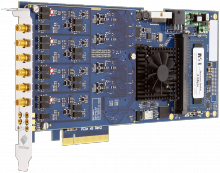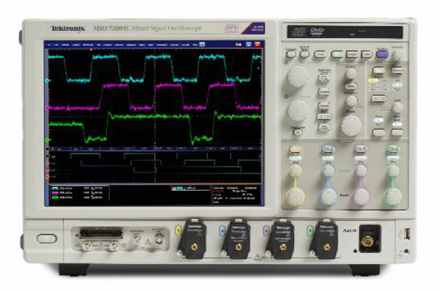Did you know? |
In 1996 Hewlett-Packard introduced the first mixed-signal oscilloscope (MSO) with two 100 MHz analog channels and 8 or 16 digital logic channels - the HP 54645. Read more...
Latest Oscilloscope News |
In 1998 the T&M company Rigol was founded in Beijing/China. In 1999 Rigol launched its first product, a digital storage oscilloscope. Read more...
We published several oscilloscope market overviews e.g. for USB, Handheld and PXI/PXIe oscilloscopes. Read more...
In 2017 Tektronix introduced the FlexChannel technology for its 5 Series oscilloscopes. Each channel can be used either as one analog or as 8 digital channels. Read more...
The worldwide oscilloscope market is valued at about 1.1 billion USD in 2012 (Frost & Sullivan) and is dominated by Tektronix, Keysight and Teledyne LeCroy.
Only 3 manufacturers are offering oscilloscopes with a bandwidth greater than 50 GHz: Keysight, Tektronix and Teledyne LeCroy. Read more...
Oscilloscope Basics |
Digitizer and Oscilloscope - Equal Alternatives?
 Can a digitizer be used as an oscilloscope? What is the difference between an oscilloscope and a digitizer? Should I better use a digitizer or an oscilloscope in my next application? These are interesting questions and the best way to start to answer these is the look up the dictionary definition of an oscilloscope: "An electronic instrument used to measure changing electric voltages. It displays the waveforms of electric oscillations on a screen."
Can a digitizer be used as an oscilloscope? What is the difference between an oscilloscope and a digitizer? Should I better use a digitizer or an oscilloscope in my next application? These are interesting questions and the best way to start to answer these is the look up the dictionary definition of an oscilloscope: "An electronic instrument used to measure changing electric voltages. It displays the waveforms of electric oscillations on a screen."
Oscilloscope Background |
Digital Debugging - better using a Mixed-Signal-Oscilloscope or a Logic Analyzer?
 Today’s technology is fundamentally balanced on an increasingly fine line between the analogue and digital domains; as data speeds increase — both within and between devices — the ‘ideal world’ of fast, clean digital transitions becomes evermore difficult to achieve. This presents new and escalating challenges when verifying faster digital signals that exhibit more and more analogue-like features. As a result it is becoming necessary to remove the hard line between digital and analogue.
Today’s technology is fundamentally balanced on an increasingly fine line between the analogue and digital domains; as data speeds increase — both within and between devices — the ‘ideal world’ of fast, clean digital transitions becomes evermore difficult to achieve. This presents new and escalating challenges when verifying faster digital signals that exhibit more and more analogue-like features. As a result it is becoming necessary to remove the hard line between digital and analogue.

 How to resolve AdBlock issue?
How to resolve AdBlock issue? 